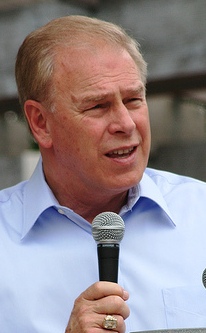Cracking Ohio’s Political Code
Unlike previous Democratic presidential candidates, Obama has taken a cue from the state’s governor and freshman senator and launched an all-inclusive 88-county strategy with an unprecedented grassroots campaign. Ohioans have never seen anything like it.
Jul 31, 2020104.5K Shares1.8M Views
Image has not been found. URL: /wp-content/uploads/2008/10/obama-barn.jpgA Barack Obama barn painting in Ottawa County, Ohio. (flickr)
COLUMBUS, Ohio — A few days back, I was in the basement of the statehouse standing on a large map of Ohio, complete with its 88 counties, etched in the floor’s marble. I walked southwest and stood on Butler, a conservative red-meat county where I was born and my parents still live. It was home, or at least a representation of it. But looking over the remainder of Ohio seemed like staring at a foreign land, whose terrain, interests, habits and ways of life could be as far removed from life in Butler County as Zaire.
To really understand Ohio, you need a far-reaching anthropological knowledge that few possess. Sometimes, people “get it.” This would most certainly include the presidential campaign of Sen. Barack Obama, now engaged in an all-out assault to win the state’s 20 electoral votes.
Obama’s forces have hunkered down in every part of Ohio, including the more conservative southwest and southeast regions. That’s not what Sen. John Kerry’s team did four years ago when it focused on only the state’s three largest cities — Cincinnati, Cleveland and Columbus. Today, in areas where Democratic volunteers haven’t been seen by voters in a generation, the party has field offices with paid staffers numbering in the hundreds. Two weekends ago, Obama volunteers knocked on the doors of 340,846 homes. The farthest distance separating Obama field offices is 38 miles. It is an unprecedented effort to win over a highly unconventional state.
Illustration by: Matt Mahurin
To some, this Ohio campaign looks like a microcosm of Obama’s 50-state strategy. In truth, though, it is a strategy taken from the playbook of Ohio Gov. Ted Strickland, whose 2006 victory ended 15 years of Republican rule. Strickland, whose campaign manager Aaron Pickrell now heads the Obama effort here, deployed an all-inclusive 88-county strategy, as did Democrat Sherrod Brown, who won a U.S. Senate seat that year.
A series of state scandals involving GOP officials helped the Democrats — including “coingate,” in which millions of dollars from the state workers’ compensation fund were invested in rare coins. Of the $50 million invested by GOP officials, only $12 million was ever accounted for. Meanwhile, Gov. Bob Taft, scion of a celebrated Republican dynasty, was convicted while in office of not disclosing gifts from lobbyists. By the end of his term, Taft was the most unpopular governor in Ohio history, according to polls.
“Brown and Strickland ran a true statewide campaign and won, and we’re following that plan,” said Obama’s Ohio deputy communications director Tom Reynolds, who was sitting in a former church in Columbus that has been converted into the Democratic Party headquarters.
Yet Brown’s and Strickland’s statewide approach most likely will not translate into a landslide win for Obama in Ohio. While Obama leads Sen. John McCain by a slim margin, all indications are that this election will be as close as the previous two presidential contests. That’s because there are districts that will not elect a Democrat. Trust me on this. If Obama can get even a toehold in a Republican district or, at the very least, contain his margin of defeat in it, he simply has a better chance in a race that promises to be tight.
“We’ve got people running the campaign … who helped Strickland crack the code in this state,” said David Wilhelm, Bill Clinton’s 1992 campaign manager and former chairman of the Democratic National Committee. “They understood you’ve got to campaign everywhere. … Strickland ran a campaign that talked about bread-and-butter issues where he spoke plainly to everyone. Sherrod ran on this idea of economic populism that is central to his image as a public servant.”
The Obama team has also adopted some of the tactics used by Sen. Hillary Rodham Clinton, who crushed him in the primary here.
“They’ve learned a lot from Hillary’s campaign,” Wilhelm, an informal adviser to the Obama campaign, acknowledged. “In order to win Ohio, you have to campaign in little patches and be willing to do tours of the Ohio River Valley. You can’t skip that. They’ve learned those lessons well.”
Both Al Gore and Kerry had sought to increase turnout in such traditional Democratic strongholds as Cleveland. What was missing — particularly by Kerry — was any effort to campaign in culturally conservative areas, where George W. Bush won by margins of 2 to 1.
“The biggest mistake that national Democrats make when they look at Ohio … is that Hamilton, Cuyahoga and Franklin counties account for less than 30 percent of the general election voters,” Wilhelm said. “You tell that to somebody in Washington, and they say, ‘What are you talking about? Cincinnati, Columbus, Cleveland – that’s the state.’ Well, it’s not the state, and it’s not even close to being the state.”
As state Rep. Ted Celeste, brother of the former Democratic governor, told me recently: “If you look at the map, one of the things you see are the number of medium- and small-sized towns. Kerry just simply did not do a good job in counties where Bush absolutely destroyed us — the smaller counties.”
It’s one thing to use someone else’s playbook. It’s another thing to execute it. Last Thursday when I sat down with Ohio Democratic consultant Greg Haas, who ran the state campaign for Clinton in 1992, he disputed the similarities between Obama’s and Strickland’s campaigns.
Haas pointed out — correctly — the effect, or lack thereof, of having a Democratic governor in office while running for president in Ohio. While Republican George Voinovich was governor in the 1990s, Clinton won Ohio twice. With the Democrat Celeste in office in 1984 and 1988, Ronald Reagan and George H.W. Bush won, respectively.
“The way Ted Strickland won is not the way Barack Obama will win,” Haas told me, recalling Strickland’s race against the African-American Ken Blackwell, who had become the state GOP’s darling.
“First of all,” Haas said, “race is the opposite factor here. In the small town where I grew up, where I’m from, I was stunned about how many people would say to me when I was back there, ‘I’m voting for one of your guys for the first time ever. I’m not voting for that black guy.’ And these were fundamentalist Christians, and as far as they were concerned, Ted Strickland was a baby killer.”
But Haas went on to say,”You cannot win Ohio by turnout alone. You have to run a battle on two fronts. You have to make sure you get your vote out — but you also have to convert.
“And conversion is not necessarily getting a Republican to turn over, or getting independents,” Haas continued. “It’s also running strong enough in Republican areas that you don’t motivate them to turn out. We make the assumption that every Republican votes, because so many of them do. But we’re talking about the difference between 78 percent turnout and 81 percent of the Republicans. Take that three percent away — obviously you have a significant factor in the race. For the average Republican who votes almost every single time … the day [may get] crowded, and all sorts of things are going on on Election Day. Do you feel like you just got to get out there and vote? Or, well, do you say, ‘It’s not so bad. I’ve got to go to the grocery store. My one vote’s not going to matter.’”
Gov. Ted Strickland (flickr)
While Haas takes issue with drawing parallels between Strickland and Obama, he marvels at the tactical approach the Obama campaign has taken. This includes correcting the big tactical flaw in Kerry’s Ohio campaign: He did not advertise on general broadcast radio, while Bush paid for a mighty presence on the AM dial.
This might seem trivial. But the fact is that a large chunk of voters get most of their news over the radio. These are the men and women living in the exurbs and outer rings of Ohio cities, people who travel 45 minutes to get to the office, then make the same long trek home at night. Like not putting people on the ground in GOP counties and towns, what Kerry essentially did was cede the airwaves and news cycle to Bush. In 2008, try driving in Ohio for 10 minutes without hearing an Obama ad.
“The Kerry campaign in 2004 on the ground did one of the best jobs to date,” Haas said. “It did a much better job than we did in ’92. But their problem was the Republicans did a fantastic job, and the air strike, air campaign from the national folks was flawed. What the Obama folks are doing is second to none. It is exponentially greater than any Democrat or Republican campaign has done before. They have over 500 employees, and they’ve been on the ground since June. They’ve got paid organizers in Zanesville, Ohio…”
When I interrupted by pointing out the field office in my hometown, Haas continued, “Yeah, exactly. I was a field director for Celeste in ’82. We sent in a volunteer organizer into Butler County for the final three weeks of the campaign. And no one had done that before. And we won the county — by the way. The fact is, we’ve got level of activity on the Obama campaign that the McCain campaign cannot match.”
Should Obama win the election, it will be because his campaign sees Ohio as I did in the statehouse basement. Rather than see it as the monolithic land mass that changes color every time CNN national correspondent John King touches it, Obama’s team knows the state is more of a quilt — with each patch requiring careful tending.
Strickland and Brown knew this, and they might have shown Obama the tactics. They might have given him the path. Now he must make their terrain his own.

Rhyley Carney
Reviewer
Latest Articles
Popular Articles

